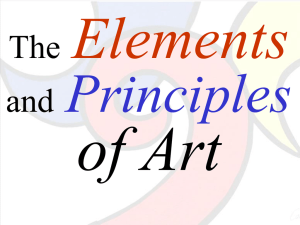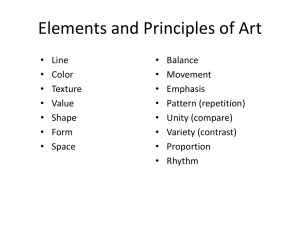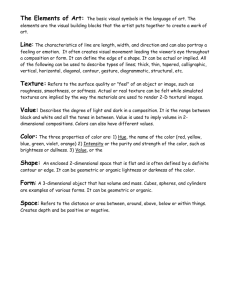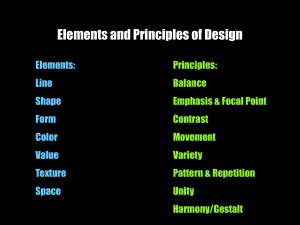The Elements and Principles of Art
advertisement
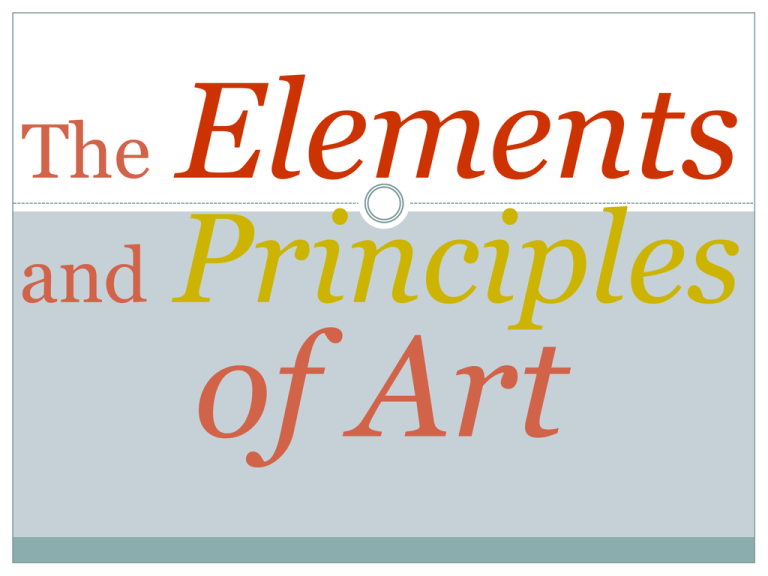
The and Elements Principles of Art The Elements of Art The building blocks or ingredients of art. A mark with length, direction and width. LINE Ansel Adams A continuous mark made on a surface by a moving point. It can be actual or implied. Gustave Caillebotte Line The path of a point moving through space is a line. Lines may be actual, (left, Matisse) or implied (right, Hopper) Pablo Picasso TEXTURE The surface quality or "feel" of an object, its smoothness, roughness, softness, etc. Textures may be actual or implied. Cecil Buller VALUE MC Escher Describes the degree of light and dark in a composition. Colors can also have a range of values. Pablo Picasso Value Value can be created using a variety of drawing techniques including: Blending, Cross-hatching, and stippling. (left, Raphael) COLOR Consists of Hue (another word for color), Intensity (brightness) and Value (lightness or darkness). Alexander Calder Henri Matisse Color All of the colors are derived from the three primary colors (red, blue, and yellow) Secondary colors are violet, green, and orange) SHAPE Shape implies form and is perceived as 2dimensional. It can be geometric or organic. Joan Miro Gustave Caillebotte FORM A 3-dimensional object that has mass and volume. It can be geometric or organic. For example, a triangle, which is 2dimensional, is a shape, but a pyramid, which is 3-dimensional, is a form. Jean Arp Lucien Freud SPACE The distance or area between, around, above, below, or within things. Robert Mapplethorpe Claude Monet Foreground, Middleground and Background (creates DEPTH) Positive (filled with something) and Negative (empty areas). Space & Perspective Space is the area in which art is organized. Perspective is representative of volume of space or a 3-D object on a flat surface (above, Escher, right, Da Vinci) The Principles of Art What we use to organize the Elements of Art, or the tools to make art. BALANCE Alexander Calder The way the elements are arranged to create a feeling of stability or equal weight in a work. Symmetrical Balance Leonardo DaVinci The parts of an image are organized so that one side mirrors the other. Asymmetrical Balance James Whistler When one side of a composition does not reflect the design of the other. EMPH Jim Dine ASIS The focal point of an image, or when one area or thing stands out the most. Gustav Klimt CONTRAST A large difference between two things to create interest, drama and tension. Salvador Dali Ansel Adams PATTERN and Repetition Gustav Klimt Repetition of a design or motif. Pattern Pattern is the repetition or reoccurrence of a design element that establishes a visual beat or rhythm. (left, Warhol and above, Klimt) RHYTHM and MOVEMENT A regular repetition of elements to produce the look and feel of movement. Marcel Duchamp Rhythm & Movement Rhythm or movement is the suggestion of motion through the use of various elements (above, Pollock, and right, an unknown artist, India) Vincent VanGogh UNITY and Harmony When all the elements and principles work together to create a pleasing image. Johannes Vermeer Unity Unity is achieved when the components of a work of art are perceived as harmonious, giving the work a sense of completion (right, Hokusai, above, Manet) VAR IE T Y Using many different elements in a work such as different shapes, textures, colors and values to create interest. Marc Chagall PROPORTIO N Gustave Caillebotte The comparative relationship of one part to another with respect to size, quantity, or degree; SCALE.
